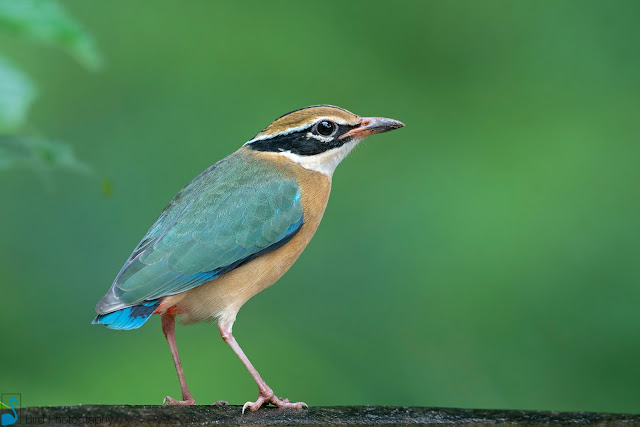The first
and last sites that you would see in Hampi are huge boulders scattered all over
the place. They looked similar and differentiating between them was not
possible in the four hours we spent walking around with my friends Rajesh and
Yogesh. It was their idea to visit HAMPI, which is known as
Pampakshetra of Kishkindha, Hampi is situated on the southern bank of the river
Tungabhadra. Once it was the seat of the mighty Vijayanagara empire..
We reached the site on 22th December 2012. As time
was short on hands, we hired a guide and stared our four hour tour. The guide
had been there since ages and knew almost exactly what each stone had to tell
on each age long story that must have gone by…
 |
| Hampi - A UNESCO World Heritage Site |
“Hampi,
austere and grandiose, is the site of the last capital of the last great Hindu
kingdom of Vijayanagara, whose extremely rich princes built Dravidian temples
and palaces which won the admiration of travellers between the 14th and 16th
centuries. Conquered by the Moslems in 1565, the city was pillaged over a
period of six months, and then abandoned.”- UNESCO
The
Archaeological
Survey
of India started the excavation work at Hampi in 1976, under a national
excavation project but had to be stopped midway and was
resumed only in the mid nineties…
 |
| Sasivekalu Ganesha Temple |
Normally, I love to
click only in the early morning light or evening light, but this is one of the occasions
when I have taken images in harsh light, and it shows…
In Hindu mythology
every good deed, work needs to start with the name of Ganesha. The guide
did the same and started the tour by showing us the Sasivekalu Ganesha Temple...
 |
| Front Back |
This monolithic
statue carved out of a huge boulder measures about 2.4 meters (8 feet). The
rear side of the monolith does give an impression of Ganesha sitting on his
mother Parvathi's lap. (see collage of two images)
How these
stones came here is not known for certain. Indian mythology has a different
tale and science tells us that they are the last remnants of a volcanic
eruption…The
monuments and sculptures are made from a special stone and designs on them are
breath-taking…
We posed in front of the Krishna Temple, Yogesh on my left and Rajesh to my right...
A
large number of royal buildings are believed to be raised by Krishnadeva Raya
(AD 1509-30), the greatest ruler of the dynasty. The core area is stated to be
enclosed by seven lines of fortifications.
 |
| Carvings on the pillars within the Krishna Temple |
 |
| Carvings on the pillars within the Krishna Temple |
Most
of the prominent monuments excavated are in the inner most circle.
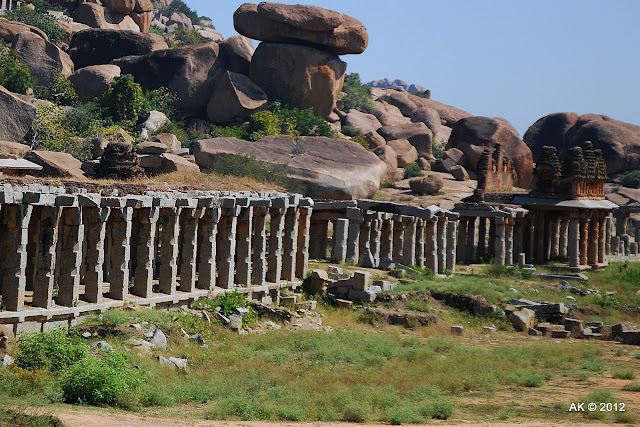 |
| Krishna Bazaar |
Krishna
Bazaar is a relatively newly excavated site in Hampi. As the name indicates
this Bazaar is associated with the Krishna Temple. Basically this was the car
street for the temple. The sacred tank (Pushkarni) of the temple too is located
next to the Krishna Bazaar.
Thanks
to the low laying terrain the whole bazaar got buried in silt over the time.
This area later turned into thickets of banana plantations. Before the
excavations it was impossible to tell that it was a marketplace once.
Restoration of the monuments is being done, which is clearly visible. (Pink colour)
 |
| Narasimha |
Narasimha’s
is the largest statue in Hampi, It is sitting on the coil of a giant
seven-headed snake called Sesha. The heads of the snake acts as the hood above
his head. The god sits in a cross-legged Yoga position with a belt supporting
the knees.
Sometimes
this is referred as Ugra Narasimha (i.e. Narasimha in its terrifying form). The
protruding eyes and the facial expression are the basis for this name.
Narasimha
(means half-man’half-lion in local the languages) is one of the ten incarnations
(avatar) of Lord Vishnu.
It seems
the original statue contained the image of goddess Lakshmi, consort of the god,
sitting on his lap. But like all the other, even this statue was damaged
seriously during the raid leading to the fall of Vijayanagara.
 |
| The Mint |
The Mint
was excavated in 1994. The area adjacent to this is the Zenana enclosure,
which was a secluded area reserved for the royal women. This walled harem
houses many interesting highlights. The major attraction is the Lotus Mahal
located at the southeast corner.
Just further down, is the Zanana enclosure...
 |
| Lotus Mahal |
The
shape of the structure is what brought it the name. The archways and the
balcony with the domed construction resemble a half opened lotus bud. Also is
the lotus bud shape carved on to the center dome.
 |
| Archway |
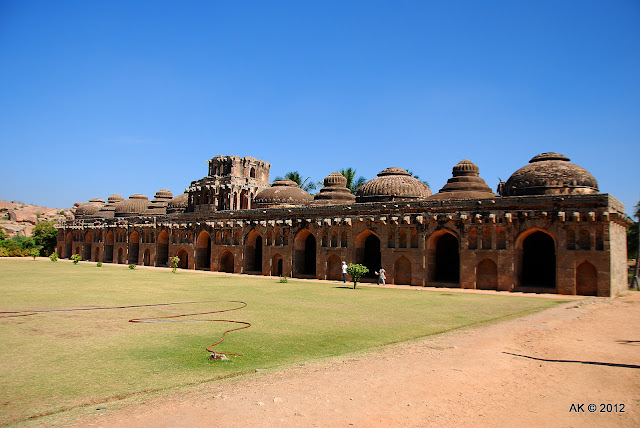 |
| Elephant Stable |
One among the few
least destroyed structures in Hampi, Elephant Stable is a major tourist
attraction. This long building with a row of domed chambers was used to ‘park’
the royal elephants. There are 11 domed tall chambers; some of them are inter-
connected. The centre one is specially decorated and big. Each doom has a
design and a tale to tell…
 |
| Watch Tower within the Zanana Enclosure |
 |
| Place for capital punishment |
 |
| Stairs that lead to the basement (bath area) |
 |
| Defaced structures |
 |
| Mahanavami
Dibba - built to commemorate victories |
|
|
|
|
|
|
|
|
|
King Krishnadevaraya constructed this in commemoration on the victory
over Udaygiri (now in Orissa). Archeologists believe that this platform
had undergone systematic enhancements by successive kings came into power
 |
| Carvings along the Mahanavami
Dibba |
 |
| Carvings along the Mahanavami
Dibba |
 |
| Stone Doors - carved from a single large stone |
 |
| Carvings on the Mahanavami
Dibba |
 |
| Stone aqueducts within this royal enclosure connects 20 or so wells and ponds. |
 |
| Aqueducts are made in such a manner that the water flowed due to gravity |
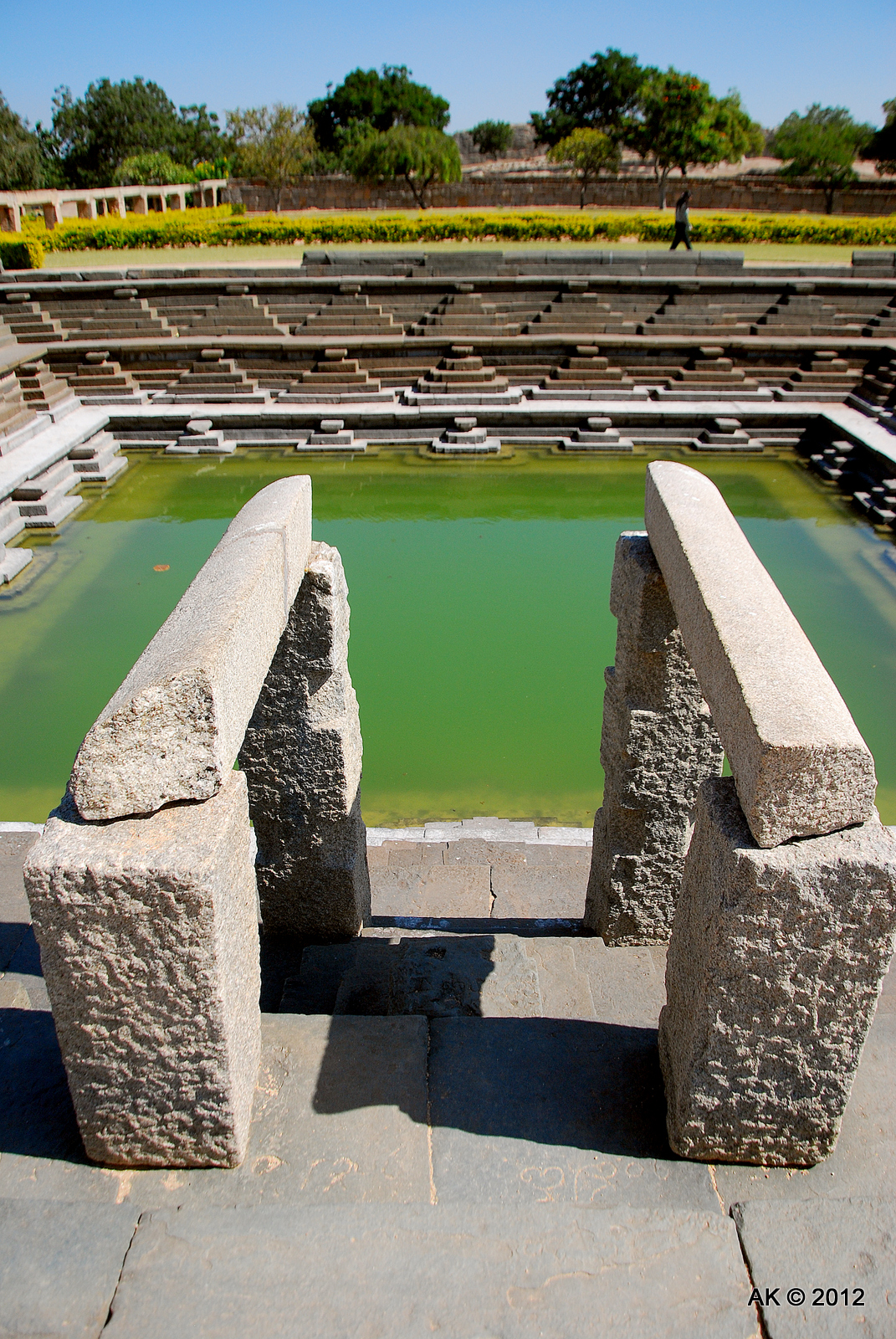 |
| Water well |
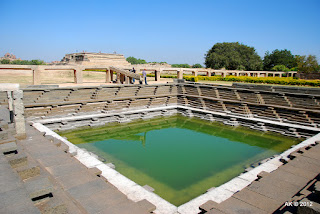 |
| Another view of the water well |
 |
| Plates - Made of Stone |
Stone plates – food
was served on these. Such stone plates were placed on a large dining area, with
an aqueduct flowing in the middle. Once the multi course meal was over, the
water from the aqueduct is simply made to flow over the plates to clean them.
 |
| View from the Queen's bath |
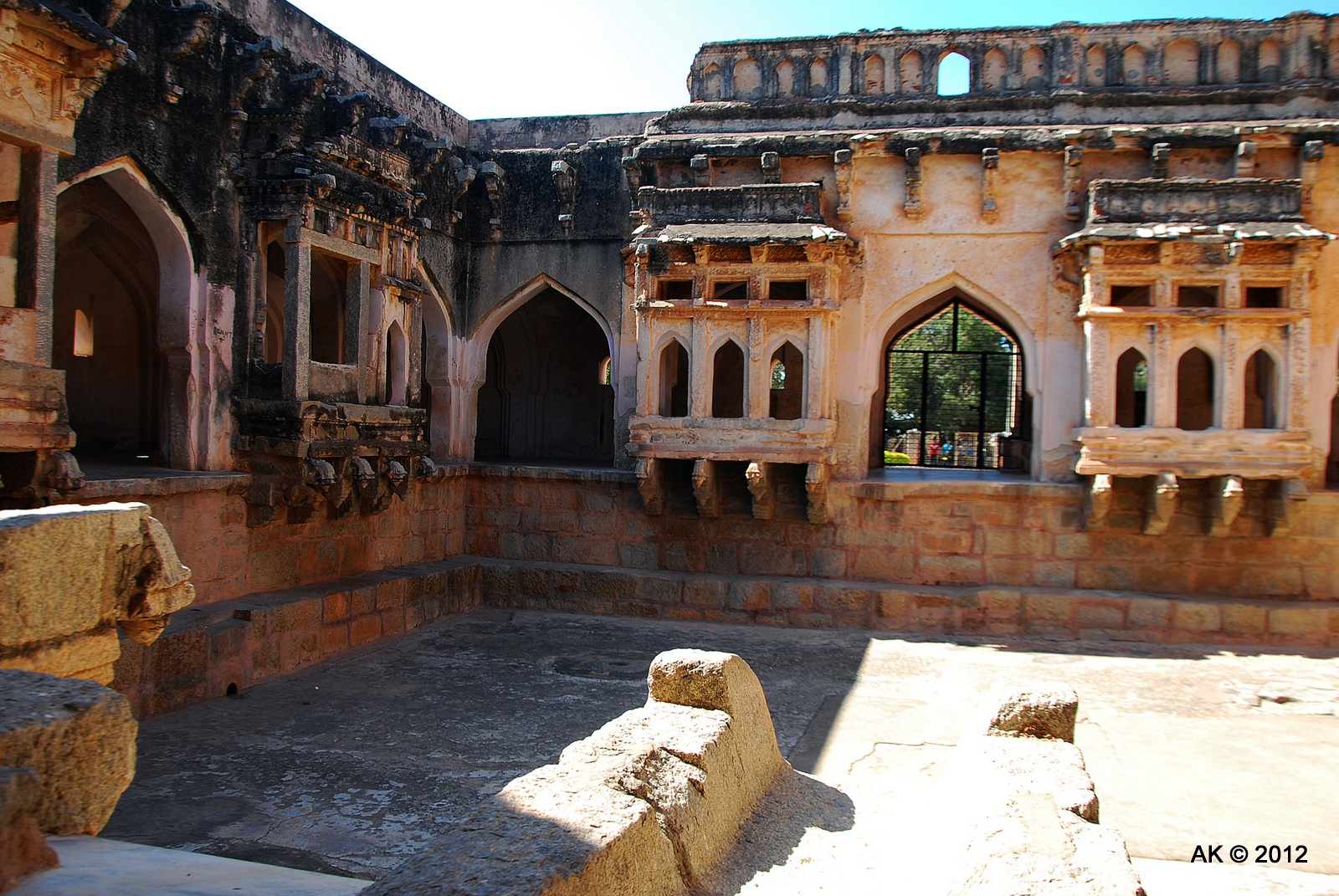 |
| Queens bath |
Aqueduct would get in water into this large area, called as the Queen's bath
 |
| Entrance to the Vittala Temple |
The main highlight of
the Maha-Mantapa, with in the temple is the richly carved giant monolithic
pillars. The pillars are popularly called the musical pillars. These slender
and short pilasters carved out of the giant pillars emit musical tones when
tapped. Probably they emit the sound of the instrument that has been carved on
it (See a collage of three images). Unmindful curiosity of the visitors has
damaged many of these pilasters and tapping on it is banned for the sake of
preservation…
Carvings showing
Horses and its trainers…
 |
| Hall adjacent to the Vittala Temple |
 |
| Defaced sculptures |
 |
| The guide explaining to us and Rajesh trying his hands on the camera.... |
 |
| Carvings |
 |
Pillars (collage of
two images) inside the temple… having a story to tell on its own…
|
 |
| Well designed Corners |
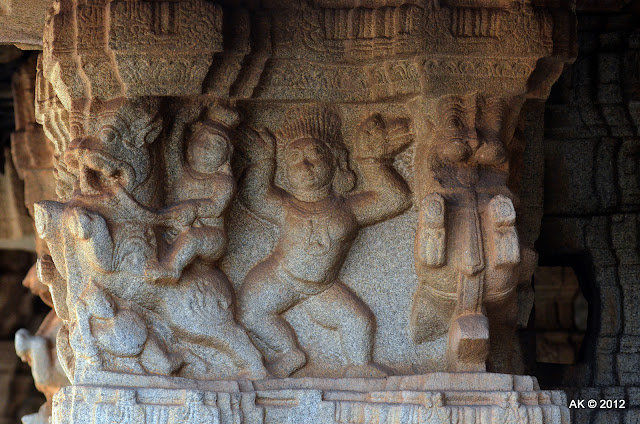 |
| Story tales on the walls |
 |
| Narasimha kills Hiranyakashipu |
 |
| Carvings |
The “Stone Chariot”,
as it is often referred is the flagship tourist attraction of Hampi. This is
not a chariot ,as the name suggests, rather a shrine built like a chariot...
 |
| Walls of the Vittala Temple |
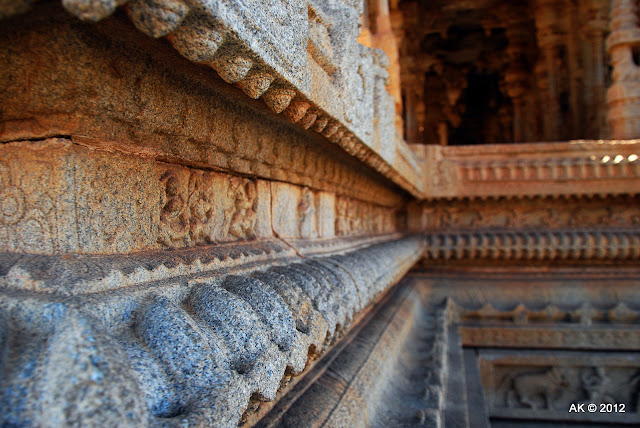 |
| Closer look at the design - walls around Vittlala Temple |
It seems this temple
looks very beautiful during monsoon. The rain water flows smoothly over the
well-designed outer surface. The flowing water forms drops over the doom like
structure (see left top corner) and then the drops fall into the ring shaped surface (see left bottom). They are well shaped and smooth. The water flows to the bottom from these smooth edges, without creating a splash or sound !!!
 |
Walls made of stones, nicely
carved and aligned.
|
We did not realise, how the time went by. It was almost 4PM and had to head out of the town. Before heading out, we are suggested by the guide to have our lunch at "The Mango Tree Restaurant"
We were made to sit on a multi-layered, stone-cut set of benches which overlooked the
Tungabhadra river. Here we enjoyed some very yummy authentic local food, which was served on banana leaf.
Hope to visit this place again, suggested period of stay - 3 to 4 days !!! Hire a Moped and see each location and listen to the story each stone has to say...


















